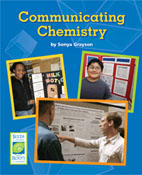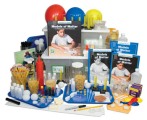Archive for February, 2013
6 Tips for Students. Communicating the Results of an Investigation.
One of the most important things scientists do is communicate. They share explanations of what that have learned with the scientific community – scientists all over the world. When scientists have explanations to share, they often write reports for scientific journals. Scientists also communicate with one another in person at conferences. They share their data and explanations by giving speeches in front of big groups and/or by presenting posters. This communication helps scientists learn from other scientists’ investigations. When one scientist answers a question, this helps other scientists investigate their own questions.
 In the Seeds of Science/Roots of Reading® student book Communicating Chemistry, students can read about a chemist who makes a poster and presents it at a conference. Reading about his experience will provide tips for students who want to share the results of their own scientific investigations.
In the Seeds of Science/Roots of Reading® student book Communicating Chemistry, students can read about a chemist who makes a poster and presents it at a conference. Reading about his experience will provide tips for students who want to share the results of their own scientific investigations.
Here are 6 helpful tips for students presenting a poster:
- Think about your audience. Make sure that someone who doesn’t already know all about your investigation will be able to understand what you did and what you found out.
- Keep it simple. A poster should be about what you were investigating, how you did it, and what you learned.
- Before you present, try to think of questions that people might ask you. Have answers to these questions in mind.
- When talking about your investigation, try to make just a few main points. You don’t need to talk about everything that happened.
- Be sure to speak slowly and clearly.
- Practicing your presentation out loud will help you figure out what to say. If you have practiced, presenting will be easier on the big day.
By presenting their ideas, students act as scientists who bring the community one step closer to answering the big questions. The big discoveries in science almost always grow out of work that many scientists have been doing over many years. That’s because big questions can be hard to investigate. Scientists break big questions down into smaller questions that are easier to investigate.
Students can read about Michael Grass, a chemist who presents a poster at a scientific conference, featured in the Seeds of Science/Roots of Reading® student book Communicating Chemistry. Grass has been investigating a better way to make nanoparticles of different shapes, making them better at speeding up a chemical reaction.
For more information about the student book Communicating Chemistry and the Chemical Changes science and literacy unit, visit http://www.scienceandliteracy.org.
Do you want to be notified when we publish new blog articles? Simply enter your email address in the “Follow Blog via Email” box located in the right sidebar.
Pluto’s Planet Status: Use Comparison Chart to Help Students Understand Solar System Objects
On February 18, 1930, Clyde W. Tombaugh, an assistant at the Lowell Observatory in Flagstaff, Arizona, discovered Pluto. At that time, it was classified as the ninth planet in our Solar System. Then, in 2006, a group of astronomers decided that Pluto should not be classified as a planet.
To help students understand the distinction, it is helpful for them to create a comparison chart to see how Pluto is similar to and different from each group of objects in the solar system. Here’s what the chart might look like:

 Students can research information online or with resources in the classroom or library. The Seeds of Science/Roots of Reading® student book What About Pluto? compares Pluto to other objects in the Solar System. Students learn that astronomers classify objects according to their characteristics. Rocky and gaseous planets, moons, asteroids, comets, and Kuiper Belt objects (icy bodies that orbit the Sun beyond Neptune) are all compared and contrasted with Pluto.
Students can research information online or with resources in the classroom or library. The Seeds of Science/Roots of Reading® student book What About Pluto? compares Pluto to other objects in the Solar System. Students learn that astronomers classify objects according to their characteristics. Rocky and gaseous planets, moons, asteroids, comets, and Kuiper Belt objects (icy bodies that orbit the Sun beyond Neptune) are all compared and contrasted with Pluto.
Here’s what the comparison chart might look like, based on research compiled by the students. (more…)



